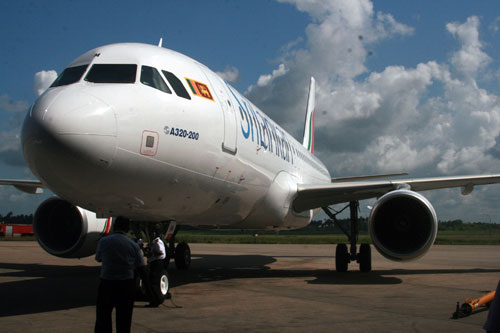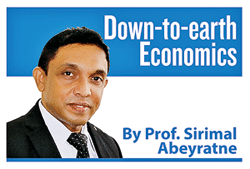Pitiful state of SOEs
View(s):
SriLankan Airlines is one of the SOEs set to be restructured
In my neighbourhood, quite often I have to go pass an office building with a name-board which carries the name of the office ending with “Authority”. It’s a state-owned enterprise (SOE), located in a rented space of a multistoried private building. When we read the names such as Authority, Board and Corporation, we know that these are commonly used names for SOEs.
Sometimes I see big vehicles such as V8 and jeeps used for escorting as well as security personnel bearing weapons; then, I used to think that the respective Minister or any other VIP must have come to the office. Other than that, I have hardly noticed any activities happening there or any public visitors going in and out of the office. I began to wonder whether there is any good reason to justify why that “Authority” even exists.
SOE website
One day I browsed the Internet searching for the “Authority” and, there it was! By experience, I know that in most of the websites of government agencies, the opening page looks beautiful and professional with pictures, statements and captions; the pictures often carry the pictures of ceremonies, speeches, meetings and others alike, attended by the VIPs.
Going beyond the opening page, especially if you are looking for any useful up-to-date information, the other inside pages are often hopeless. The website of this particular “Authority” was no different. I tried the “statistics” page, but there was nothing useful about the “Authority” other than some national data from some other public sources. Then, I looked for the Annual Reports; the latest one was for 2016, which is six years old.
Then I began to wonder whether this particular Authority is making any positive contribution to the economy at least to cover its operational cost – staff salaries, building rent, office maintenance, fuel and transport, utility costs, etc.
With all the perks and government’s guaranteed safety, they even jeopardise private businesses operating in the same area. Private businesses do not operate efficiently when the market is being distorted by the SOEs. Thus, actually some of the SOEs make negative contributions to the economy.
Politics of SOEs
In their public addresses, many politicians used to say that “we don’t sell our ‘government assets’ to anybody; they belong to our people!”. Having heard that politically-appealing statement, many people would clap. The politicians who promised not to sell state enterprises won the elections. Politicians who would be likely to reform them lose the elections; even if they want to reform them, they wouldn’t dare to say it in public fearing the dire political consequences of it.
 This is the history of our SOEs over the past 40 years; the issue became acute over time so that over the past 25 years there have been almost no reforms in the SOE sector. As a result, they were subject to mismanagement, and then passed the losses to the people to compensate with their tax money or borrowings; and the SOEs apparently accelerated the country’s downfall. Here we are now in an unprecedented economic crisis, while the bleeding SOEs over the years and decades have been a major cause of it.
This is the history of our SOEs over the past 40 years; the issue became acute over time so that over the past 25 years there have been almost no reforms in the SOE sector. As a result, they were subject to mismanagement, and then passed the losses to the people to compensate with their tax money or borrowings; and the SOEs apparently accelerated the country’s downfall. Here we are now in an unprecedented economic crisis, while the bleeding SOEs over the years and decades have been a major cause of it.
When the IMF said it over and over when Sri Lanka entered IMF-assisted programmes on 16 times, we condemn it saying “they are IMF conditions imposed on us” so that we must avoid the IMF. Politicians never brought an alternative solution; even if they put forward something, they were not pragmatic! On the other hand, we never fulfilled the IMF conditions either so that we had to repeat going after the IMF over and over; it’s still not ended.
The crisis is, however, a golden opportunity that should never be missed out; most people have realised that they were cheated and held to ransom: An opportunity that should never be missed in order to reform the bleeding SOEs once and for all.
What’s their problem? How did they contribute to the crisis? How do we reform them? Today, I am going to shed some light on these questions, which are nationally important issues.
Report of Advocata
The Advocata Institute’s latest report titled “The State of State-Owned Enterprises 2022” provides concise information with facts and figures on the fate of Sri Lanka’s SOEs; and the report was presented at Advocata’s two-day “Reset Sri Lanka” conference held at the BMICH last week.
As per information on the state of the SOEs, there are 399 SOEs in Sri Lanka, out of which 52 are categorised as “strategically important” state-owned business enterprises. Having understood that Advocata’s Report is about these 52 SOEs, I complained to Ravi Ratnasabapathy, the Chief Project Consultant of the Report: “There is not even basic information about the 399 SOEs? It’s all about these 52 key SOEs only”.
His answer was that “most of them don’t have even the ‘basic’ information”.
He explained further: “I tried two years under the RTI (Right-to-Information Act)’, but most of them didn’t respond even to the RTI request. Some of them responded, the scattered information they provided collecting from here and there were incomplete and unorganised; we cannot use them for any systematic analysis”.
He brought out another point of argument: “The more you give information, the more you invite questions; if you don’t give any information, there will be no questions! For instance, out of the 399 SOEs, only 15 per cent have provided financial information for the year 2020.”
Corporate governance
The aggregate losses of all 52 SOEs for the past 15 years (2006-2021) have been Rs. 1,500 billion. The profits have also amounted to Rs. 1,500 billion, while the government banks and other financial companies have made the biggest profits. SOEs are also indebted mostly to the state-owned banks which are categorised as strategically important SOEs; besides, SOEs can borrow as the government guarantees such borrowings.
The 52 SOEs have Rs. 1,500 billion government-guaranteed total debt, while some of the SOEs are also having accumulated foreign currency debt in millions of dollars. Ultimately, it’s the government which has provided guarantees for SOE debts so that it may be the taxpayers who have to repay SOE debt.
The Advocata Report has evaluated the standards of corporate governance of the 52 SOEs using indicators under four aspects as (a) submitting annual reports, (b) following auditing standards, (c) adhering to RTI requirements and, (d) providing access to information. In general, the scorecard on corporate governance does not look good; adhering to RTI has been the poorest area of governance. On the positive side, ‘having a website’ has scored well as an indicator under accessibility of information even though the information reported there is not up to the standards.
Why after SOEs?
Why are the SOEs so important? Because they mismanage public funds, they eat into taxpayers’ money, they are used for corruption and, they have made a big contribution to the current economic crisis.
Consequently, SOE reforms have been a priority area of policy discussions and debates over the past 40 years, but there have been no significant improvements particularly after the early 2000s. Rather there has been a policy reversal since 2005 which aimed at re-nationalisation some of the privatised SOEs and expropriation of privatised underperforming SOEs.
Given the economic crisis of the country, today SOE reforms present an unavoidable option for any government. It is, perhaps, the most difficult area for reforms, but the government has no choice. It is not an exclusive problem of Sri Lanka.
Most of the countries in the world have been adopting various corporate governance models to reform their respective SOEs. The removal of state controls and political interference, introduction of competition and market principles, and adopting better regulatory mechanisms have been the cornerstones of SOE reforms.
(The writer is a Professor of Economics at the University of Colombo and can be reached at sirimal@econ.cmb.ac.lk and follow on Twitter @SirimalAshoka).
Hitad.lk has you covered with quality used or brand new cars for sale that are budget friendly yet reliable! Now is the time to sell your old ride for something more attractive to today's modern automotive market demands. Browse through our selection of affordable options now on Hitad.lk before deciding on what will work best for you!


